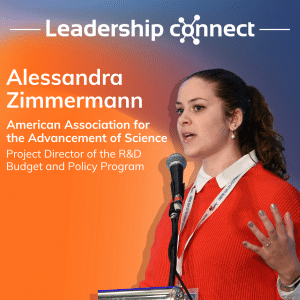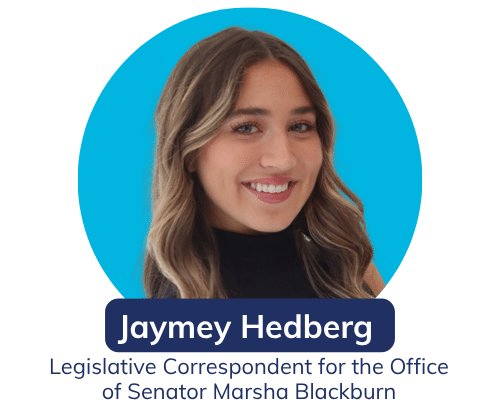by: Sarah Clein, Leadership Connect
In times of uncertainty, staying connected and informed can make all the difference. Leadership Connect’s Government Shutdown Perspectives interview series is part of our ongoing effort to provide clarity, support, and community for those navigating the challenges of the shutdown. Through thoughtful discussions with leaders across government, associations, and industry, we aim to share practical insights, personal experiences, and resources to help public-sector professionals lead with confidence and stay grounded through ongoing uncertainty.
Federal Research and Development through the Shutdown
Leadership Connect’s Sarah Clein recently spoke with Alessandra Zimmermann, Project Director of the R&D Budget and Policy Program at the American Association for the Advancement of Science (AAAS). Zimmermann has been tracking how the shutdown is affecting federal research and development, providing analysis and resources to help the science community navigate through this disruption.
Can you start by describing your role at AAAS and how your team studies the flow of federal research and development funding?

My role was recently upgraded. I am now the Project Director who runs the R&D Budget and Policy Program at AAAS. The R&D program turns 50 next year, and has basically been a third-party observer of how the federal government spends money on science since the very beginning.
Obviously, the methods and the speed of tracking the federal government has changed a lot over those 50 years. What I do now is a lot of tracking of appropriations in real time. Anytime there is movement on the bills, I update people about what the changes are. I also do a lot of contextual analysis because data is great, but it’s hard to parse for most people.
I write reports contextualizing appropriations numbers, understanding, for example, what a shutdown is and what it means, what a continuing resolution is and what it means and how those two things are different and still neither of them is a final budget. I write pieces that explain the reasoning and the advantages of federally funded science over, let’s say, privately funded or philanthropy funded science, because they’re all very different things and need to coexist in one ecosystem for it to thrive.
How has the shutdown changed the focus of your role and AAAS’s broader efforts to analyze, report on, and support the research community during this period?
I can talk about my program specifically because it has been affected by the shutdown. Obviously, there has not been any appropriations bill movement through Congress. So, a lot of my day-to-day tracking of the federal government and its funding plans has basically halted. During this shutdown, I had to move away from real-time tracking and work on longer-term projects that I couldn’t get to during the rest of the year.
A couple of weeks ago, I completely revamped our historical dashboard because I finally had the time to sit down and look at all the data we’ve collected over the past 50 years, process it, validate it, and then provide that to the public as a resource in case anyone wants to do longitudinal analyses.
As for the rest of AAAS, most of our programming did not get impacted by the shutdown at all because the vast majority of AAAS programming is not federally funded. Even the programs that are funded did not necessarily get stop-work orders. So, everything we do continues on through the shutdown, including making our members aware of what the shutdown is doing. We talk to our members through various means, emails, newsletters, and webinars about what’s going on. So, that’s all continued.
Based on AAAS’s research, which agencies or research areas have experienced the greatest disruptions during this shutdown?
Well, there are certainly a lot of big instrumentation projects and data sets that have been impacted by the shutdown. For example, synchrotrons typically pause operations during a government shutdown. So, if you had a slot to do x-ray crystallography on whatever sample you’re producing, you then have to rebook for a new slot and that can significantly delay your work.
Other impacted areas would include all of the statistics that the federal government provides. This includes groups like the Census Bureau, NSF’s National Center for Science and Engineering Statistics, and the Agricultural Research Service, which do statistical data collection. Most of those employees have been furloughed, so the collection and processing of that data is likely going to be delayed quite significantly.
What resources would you recommend to federal researchers, both furloughed and essential, right now?
Right before this shutdown, we had a webinar about what shutdowns typically look like. I also put out a report outlining basically examples from the 2013 and 2018 shutdowns and what we could expect would happen to federal workers and to scientists who interact with federal infrastructure. So, we provided preemptive information on what could happen to people in a shutdown.
AAAS has a newsletter, what we call The Policy Alert, for AAAS Members who want to be aware of what’s happening in the science policy world, how the shutdown is impacting things, and the state of negotiations during the shutdown. It is published every Tuesday and has a rundown of everything that impacts science policy.
I have published reports that describe what a shutdown is and what typically happens during them. The way to end the shutdown right now looks like a continuing resolution. I also have an explainer on what that means and the advantages and disadvantages of a continuing resolution. So, we have explainers for all these things if you’re unfamiliar with the concepts and want a broader understanding of how they might impact you.
Could you summarize your “Research on R&D Funding: Impacts of a Continuing Resolution” report for our audience?
A shutdown is obviously a complete shutdown of everything that is non-essential and essential is defined very, very loosely. The most variable thing about a shutdown is that the administration gets to decide who is essential and who is not. Broadly speaking, essential means you are preserving the life and/or function of entities. So, people involved in clinical trials that are ongoing are considered essential because they need to keep working to make sure the patients stay alive and healthy. People who work with animal models have an ethical obligation to keep the animal models alive, so they are considered essential.
A continuing resolution (CR) essentially means the previous year’s budget is being extended for a period of time. It is not as thorough as a formal appropriations bill signed into law. A CR has less leeway in its interpretation and language has to be added if Congress wants changes. That means if a new program wants to start up, it needs to be added into the continuing resolution or else it cannot start, even during the new fiscal year. If funding is to be increased or decreased for an account, it has to be added in very intentionally. If a program does not get mentioned in a continuing resolution, it cannot change from its previous budget, which is a lot more limiting.
Once the shutdown ends, what do you expect the bounce-back to look like for federal R&D and for AAAS?
I will get back to tracking appropriations. They’ve said that as soon as the shutdown ends, they already have the minibus, the three-bill package, which includes MilCon [Military Construction]-VA [Veterans Affairs], Agriculture, and the Legislative Branch, that is almost fully negotiated between the House and the Senate. They said that the minibus is ready to go to the floor and start getting votes immediately.
They’re also considering packaging the Defense, and Labor and Health and Human Services bills into a minibus. That one’s not as finalized, but I’d obviously be tracking that if it manages to make it to the floor. Basically, I would go back to operations as usual, making sure people know how the appropriations bills are being handled, what stage they’re in, what the outlooks for the agencies they might care about are.
For federal R&D, it’s a little bit less sure. Just yesterday, CBO released a report saying that there is between $7 and $14 billion of our GDP that has been lost to the shutdown already. And our GDP is likely to be 1% to 2% lower than predictions because of the shutdown. There’s an economic cost to the shutdown that will not be recovered. That is lost for good.
Part of that economic cost is obviously going to be R&D because the vast majority of federal researchers are currently furloughed. We’re also going to see those delays in statistical reports coming out, which previously some of them have caused economic crashes.
In my shutdown report, I mentioned that a report out of the USDA on crop pricing caused a minor crash that made people overpay for bulk crops for a short time. So, there are going to be economic impacts of all of these tracking reports being delayed.
There is also the fact that it takes time to do the work that has stopped during the shutdown. Federal workers are going to receive back pay for the work they were not legally allowed to perform. Then they will need to catch up on all of it, which is going to take time. And we’re just going to keep compounding those delays and those costs as we get out of the shutdown. So, the longer a shutdown is, the more expensive it will be.
Is there anything else you would like people to understand about AAAS’s role during this shutdown period and potentially afterwards as well?
AAAS’s work does not stop because of the shutdown. We have been changing some of our work to pay attention to the impacts of the shutdown, so we are continuing to do everything we can for the science community.
We have still been meeting with Congress and talking to them about the importance of science and R&D. We are still doing everything we can to make sure that science is front and center in their mind when they think about the budget and policy priorities going forward, because it is a huge economic driver. Without R&D, the US would not be the US we know today. We have been, and will continue to, make that a priority.
More of Zimmermann’s and AAAS’s reports and dashboards:
- Appropriations Dashboard
- Explainers on the budget (general)
- Explainers on the budget (this year)
- Historical Dashboard
Zimmermann’s Social Media:







